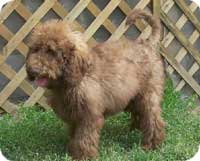Labradoodle History

What is a Labradoodle and how did they start?
The origin of the Labradoodle takes us to Australia, where breeder, Wally Cochran of Northern Victoria, was asked by a blind woman in Hawaii, to come up with a "low allergy" guide dog. Since saliva and fur are the leading cause of animal allergies, extensive testing was done to find a non-allergenic dog. After much consideration in the early 1980's, he decided to breed a Labrador Retriever (for it's good nature) and a Standard Poodle (for it's intelligence and allergy friendly coat. After the first breeding some of the puppies lacked shedding and doggy odor. The first puppy was born that passed the saliva and fur test. This was encouraging and he decided to continue on.
In the early generations of Labradoodles, there were many different coat types. Some of them still shed, and were not good for people with allergies and asthma. Only the best of the litters were used for future breeding. Over the years and many generations later, we have the Labradoodle as it is known today, that is reasonably consistent in coat characteristics and allergy friendliness. Occasionally there is a puppy that does not meet the standards, but those are fewer and fewer. Physical characteristics are just part of what has been the focus since the '80's; temperament has been carefully bred as well.
Many of the first generation (Lab. to Poodle) and early generations are not low allergy dogs. Some appear to be as puppies, then lose their puppy coat and grow a more wiry coat that sheds. First generation (F1) can produce a few good coats. Second generation (F2) can produce a better litter with an increase in allergy friendly coats. Third generation and beyond (multi-generation) will produce fairly consistent litters of allergy friendly coats.
There are three coat types:
Hair Coat
The Hair Coat is not recommended for allergy sufferers, because it is likely to shed. Depending upon the genetics, the hair coat can be long or short in length, wiry or plush in texture. It ranges from flat and straight to curls down the back and possibly wavy, and minimally to profusely shedding. This kind of coat is very typical of first generation labradoodles. For instance, if one parent of the litter is a Labrador Retriever, there is a very high probability that most of the puppies will have hair coats. Because they never have to be trimmed or clipped, they require the least amount of care.
Wool Coat
WOOL coats, similar to that of a poodle, do not shed and are allergy and asthma friendly. Length of the coat is a matter of preference. If you like a long flowing coat, more maintenance is required. If you like short coats, you will find the Wool coat very easy to keep looking great. Grooming and a scissor trim or electric clip three or four times a year is about all you will need to do.
Fleece Coat
The Fleece Coat is the ultimate coat for allergy sufferers and easy maintenance. While shedding is possible, it is rare. It has a soft texture, and ranges from soft flowing swirls to more densely flowing spirals. Unlike the WOOL coats, you can clip, scissor or shave a fleece coat and it will grow back almost perfectly the same.

